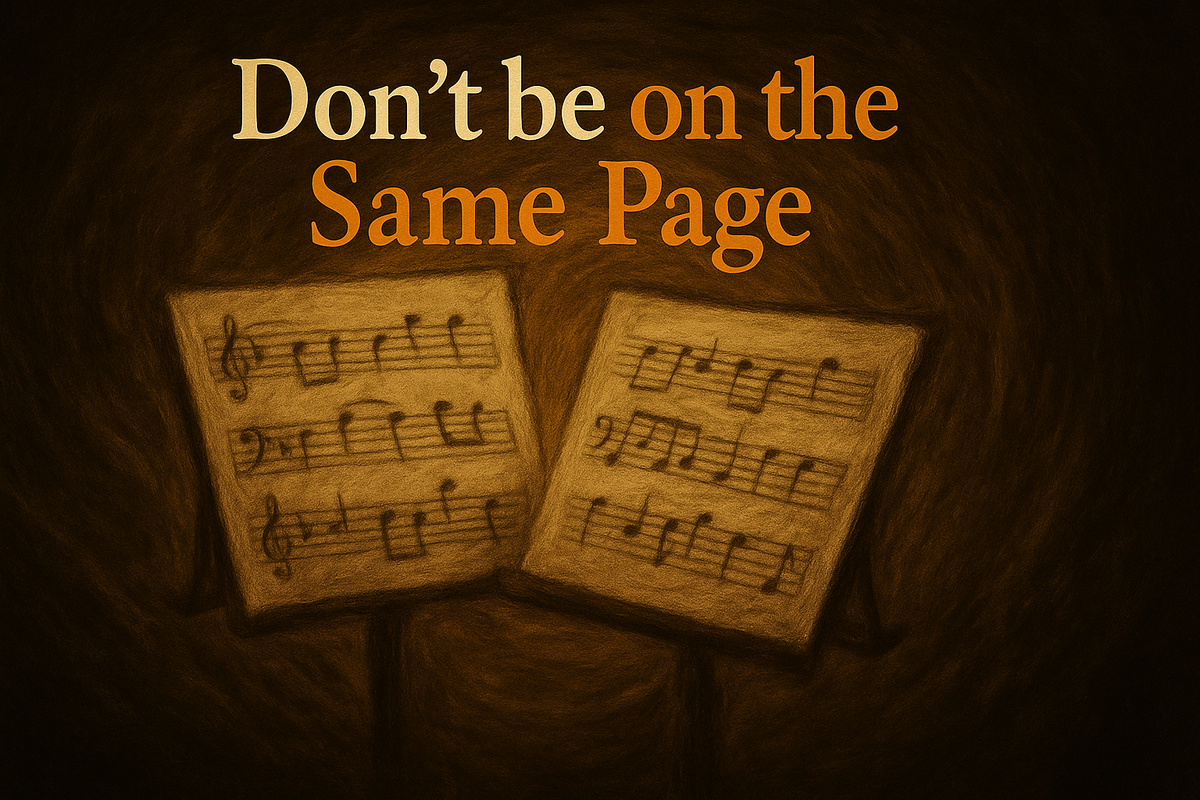Don’t Be on the Same Page
The goal isn’t to agree on everything. That kind of forced sameness backfires into a false sense of cohesion. The goal is to make space for difference. To develop fluency in one another’s inner world. To build a shared context—so the tension is generative, not destructive.

Being on the same page isn’t what we think it is. Or at least, it shouldn’t be—because that conception of connection is a trap. It fakes unity while hiding disconnection.
The way we’ve been using this term leads us astray. There’s a better way to understand it—and that shift changes everything.
You’re not going to perfectly align with your partner, your cofounder, your team, your teenager, or your in-laws no matter how hard you try.
Stop trying.
One source of the phrase 'being on the same page' comes from orchestras—where musicians read from sheet music. They're on the same page number, same measure, yes—but the notes on those pages aren't the same. The trumpet doesn’t play the same notes as the violin. The bassoon isn't mirroring the flute. Each page is uniquely scored for each instrument. But together, they create harmony.
That’s the heart of it. We mistake 'same page' for 'same voice.' But it was never meant to mean uniformity. It meant shared timing. Shared movement. Individual parts playing together in unison, in tune and in sync.
Because here’s a truth: you don’t need to be on the same page. You just need to know what page the other person is on.
That’s it. That’s the trick. That’s how relationships stop feeling like tug-of-war.
Understanding doesn’t require agreement. And alignment doesn’t require assimilation.
But when we skip the work of actually listening to each other—when we race to “resolve” before we reveal—we build shallow agreements on deep misunderstandings. The point isn’t always to fix it.
One thing I’ve learned from my work is this: it’s not about the answer. It’s about whether you—or your pair, or your team—can sit in the discomfort of the question.
That’s where the real work happens. That’s where clarity starts to surface. Without that, we mistake quick solutions for actual connection. And then we’re shocked when the house collapses.
Ever sat in a meeting nodding while silently thinking, “They don’t get it. They don’t get me. And I’m too tired to explain again. I'll just go do it myself.” Yeah. That’s not alignment. That’s resignation wearing deodorant.
And in romantic relationships?
Sometimes we perform harmony just to keep the peace. “We’re good, right?” becomes code for “Let’s not open that door.” We avoid the real conversation by agreeing to pretend. Until someone brings up vacation plans—or how they load the dishwasher like an abstract artist on LSD.
The goal isn’t to agree on everything. That kind of forced sameness backfires into a false sense of cohesion. The goal is to make space for difference. To develop fluency in one another’s inner world. To build a shared context—so the tension is generative, not destructive.
Because when two people understand what story the other is living inside, you don’t have to keep rewriting your script to match. You just stop talking over each other’s plot twists.
What I've seen from over 1200 pairs in real, honest conversations in {THE AND} is this: most people aren’t arguing to be right. They’re arguing to be heard.
To be seen.
And when they stop reaching for the answer and instead settle into the tension of not knowing but witnessing—when they allow space for discomfort without forcing resolution—that’s when the real shift begins.
So the question isn’t how do we get on the same page? But rather can I respect your page without needing to rewrite it?

Comments ()